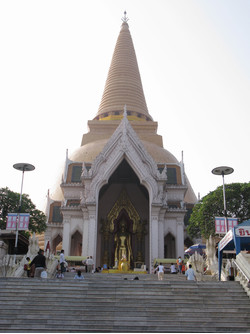Artwork Search
Arts in Southeast Asia Database
Phra Pathomchedi
Keywords : Bell-shaped Chedi, Phra Pathomchedi
| Site common name | Wat Phra Pathomchedi Rachaworamahaviharn |
|---|---|
| Type of artwork | Architecture |
| Sub district | Phra Pathom Chedi |
| District | Mueang Nakhon Pathom |
| Province | Nakhon Pathom |
| Region | Central |
| Country | Thailand |
| Geographic Coordinates Decimal degree | Lat : 13.8196296 Long : 100.060197 |
| Geographic Coordinates UTM | Zone : 47 P Hemisphere : N E : 614586.12 N : 1528031.64 |
| Place of artwork | At the centre of the temple |
| History of production | In 1831 AD when Monk Mongkut went on the pilgrimage outside the capital city, he visited a large bell-shaped stupa with prang-typed top in Nakhon Chaisri. Because of its size, he thought that the stupa might be the first religious architecture after when Ashoka the Great sent two Buddhist monks to Suvarnabhumi, he thus called Phra Pathomchedi. When he came back to Bangkok, he asked King Rama III for a permission to restore the stupa. Nevertheless, the request was refused because the king thought the restoring stupa in forest would not benefit for anyone. Then when Monk Mongkut left the monkhood and ascended to the throne, he ordered Somdej Chaopraya Borommahaprayurawongse to be in charge of the stupa restoration in 1853 AD. However, he died before the work was done, so the king ordered Chaopraya Dipakornwongse Mahakoshadhipati to take the position. The celebration was held after the restoration completed and later in the reign of King Rama V, the golden tiles were attached to the stupa. |
|---|---|
| Art | Phra Pathomchedi is the largest bell-shaped stupa in Thailand. Its anda is above the veranda in circular plan, where there is a clioster connecting viharns in the four directions. Its platform starts with a set of lotus-shaped pedestal, a set of pyramidal wires, an anda, a ballang in sqaure plan surrounded by supporting pillars and the cylindrical plump finial. The buddha figure in the northern viharn stands for his birth. The buddha figure in the easthern viharn stands for his enlightenment. The buddha figure in the southern viharn stands for his first teaching and The buddha figure in the western viharn stands for his attaining to nirvana. |
| Key academic information | King Rama IV visited the ruined large stupa when he was a monk. He thought this largest stupa of Siam might be the first religious architecture after when Ashoka the Great sent two Buddhist monks to Suvarnabhumi. Therefore, after he ascended to the throne, he ordered to restore the stupa and named Phra Pathomchedi. The later study found that Phra Pathomchedi is a Dvaravati stupa. |
| Notice | King Rama VI restored a buddha image from Sri Satchanalai, Sukhothai Province. Then he erected this buddha image in front of the stupa in the north and named Phra Ruangrojanaridh Sri Indradityadharmobhas Mahavajiravudhpujaniyabopitr. King Rama VII ordered to store King Rama VI’s relics inside Phra Ruangrojanaridh’s pedestal. |
| Period | Historical Period |
| Art period | Rattanakosin |
| Age | 20th century AD |
| Religion | Buddhism |
| Sect | Theravada |
| Religion and belief | Theravada Buddhism |
| Legend | Phra Pathomchedi mythology or the story of Phraya Kong – Phraya Phan gives information about the building of a bell-shaped stupa with the height of the dove-fly level and installing buddha relics inside the stupa by Phraya Phan as a sin redemptiom from murduring his father, Phraya Kong. |
| Related artwork | The restoration of Phra Pathomchedi in the reign of King Rama IV is related to a bell-shaped stupa in Sri Lanka because the king believed that the style was the oldest and simpliest. However, some features such as a set of pyramidal wires shows the relation of Phra Pathomchedi and Ayutthaya bell-shaped stupa. |
| Type of License | Attribution-NonCommercial-NoDerivs (CC BY-NC-ND) |
|---|---|
| Rights | Princess Maha Chakri Sirindhorn Anthropology Centre |
| Date of record creation | 2015-06-15 |
| Record creator | Patsaweesiri Premkulanan |
| Bibliography | กองโบราณคดี กรมศิลปากร.ทะเบียนโบราณสถานในเขตหน่วยศิลปากรที่ 2.กรุงเทพฯ: กองโบราณคดี, 2538. ทิพากรวงศ์, เจ้าพระยา. เรื่องพระปฐมเจดีย์. กรุงเทพฯ : มูลนิธิพระบรมราชานุสรณ์พระบาทสมเด็จพระมงกุฎเกล้าเจ้าอยู่หัว ในพระบรมราชูปถัมภ์, 2555. นฤมล บุญญานิตย์. การบูรณะปฏิสังขรณ์พระปฐมเจดีย์ : กรณีศึกษาจากเอกสารจดหมายเหตุ (วิทยานิพนธ์ศิลปศาสตรมหาบัณฑิต สาขาวิชาการจัดการจดหมายเหตุและเอกสาร บัณฑิตวิทยาลัย มหาวิทยาลัยศิลปากร, 2548). |


